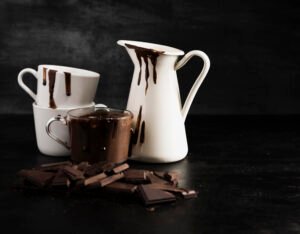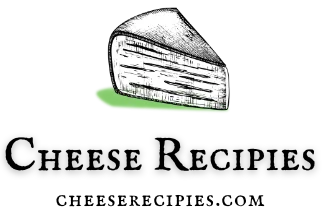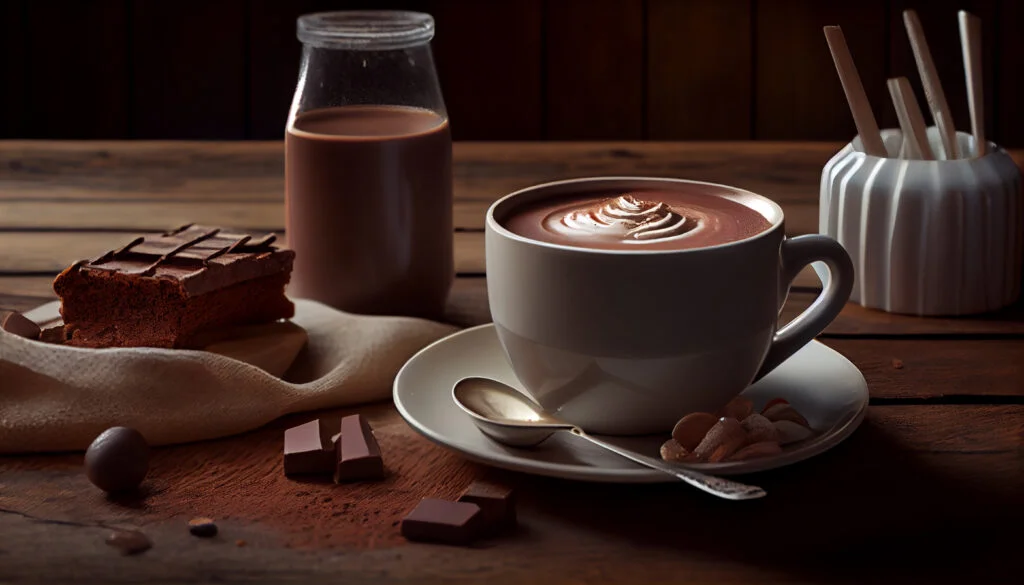Reveal the Mouthwatering history of hot chocolate, from its Aztec beginnings to current threats. A sweet story that warms each cup!
An overview:
History of Hot chocolate is something more than a joyful refreshment; it has a rich history that stretches back centuries. People from one side of the planet to the next feel a debt of gratitude, whether on an infected winter night or as a sweet treat.
This article will take you on a sweet Journey and the history of hot chocolate through the opportunity to reveal the historical Background of hot cocoa. From Outdated ceremonies to cutting-edge top choices, we should investigate how this beloved beverage became.
Ancient Beginnings: The Aztec and Mayan Origins
The story of hot Cacao starts with the Aztecs and Mayans, who utilized history of hot chocolate, chocolate beans for some reason. They made an unpleasant beverage from ground Cacao blended in with water, flavors, and in some cases honey. This drink was exceptional and often used in rituals or served to important guests. For them, Cacao was a gift from the gods, symbolizing wealth and power.
In these ancient cultures, cacao was also valuable as currency. People would trade cacao beans for goods and services. The drink was enjoyed during celebrations and ceremonies, showing its importance in their society. The Aztecs believed that Cacao gave them strength and energy.
Hot Chocolate Arrives in Europe:

In the mid-1500s, Spanish travelers took cacao back to Europe after experiencing it in the Americas. From the beginning, hot cocoa remained a harsh beverage, however, Europeans immediately added sugar and flavors to make it better. This change made it popular among the wealthy, who enjoyed drinking it in lavish settings. Soon, hot chocolate became a fashionable drink at social gatherings.
As it spread across Europe, different countries began to put their twist on hot chocolate. The drink became associated with luxury and Elegance, often enjoyed by the elite class. Cafés opened in cities, where people gathered to sip their rich beverages. This marked the start of hot chocolate’s journey to becoming a beloved beverage worldwide.
The Transformation in the 19th Century:
The nineteenth century brought large changes in the method of production of hot cocoa. With the Modern Insurgency, new machines took into account the large-scale manufacturing of chocolate items. This implied that chocolate became less expensive and more open to everybody, in addition to the rich. Subsequently, hot cocoa turned into a typical beverage in families across Europe and America.
Advancements likewise changed the taste and surface of hot cocoa. Cocoa powder was made, making it simpler to blend in with milk or water. The new techniques took into account creamier and better hot cocoa, which enchanted quite a large number. Individuals started to appreciate it as a soothing beverage, particularly in colder months, and it turned into a staple in many homes.
Hot Chocolate in Modern Times:
Today, hot cocoa is loved by individuals of any age all over the globe. It comes in many forms, from moment blends to rich, hand-crafted recipes. Numerous bistros offer gourmet versions with whipped cream, marshmallows, and different flavors. This drink has turned into a bubbly #1, particularly during winter occasions.
Territorial varieties have likewise arisen, exhibiting various flavors and fixings. For instance, Mexican hot cocoa is frequently flavored with cinnamon and vanilla, while Swiss hot cocoa is known for its richness. As individuals keep on investigating better approaches to appreciate hot cocoa, its prevalence just develops, guaranteeing it stays a treasured beverage.
Cultural Impact of Hot Chocolate:
Hot chocolate altogether affects culture and customs all over the globe. It is frequently connected to comfort and warmth, making it a go-to drink during chilly climates. Numerous families have their extraordinary recipes, making enduring recollections around this sweet beverage. It is likewise a famous treat during bubbly events, similar to Christmas and Valentine’s Day.
In pop culture, hot chocolate shows up in motion pictures, books, and tunes, presenting its comfortable appeal. It addresses euphoria and fellowship, uniting individuals to share a warm cup. From exemplary movies to cutting-edge celebrations, hot chocolate keeps on being an image of satisfaction and joy in many societies.
Conclusion:
The journey of hot chocolate is an interesting one, loaded with rich flavors and customs. From its starting points with the Aztecs to its advanced fame, this drink has caught hearts around the world. The historical backdrop of hot cocoa shows us how food can interface us with various societies and times. As we are also enjoying our cups today, we can see the value in the long and sweet excursion it has taken.
FAQS:
How did the Aztecs initially set up their chocolate beverages?
Firstly they grind cacao beans and mix them with water, a portion of the time honey and flavors for pleasantness.
What's the main difference between hot cocoa and hot chocolate?
Hot cocoa is usually produced using genuine chocolate, while hot chocolate is only produced using cocoa powder and contains more sugar and milk as compared to that of hot cocoa.
For what reason did hot cocoa turn out to be so well-known in Europe?
Hot cocoa became well known in Europe since it was improved to taste better, and it was related to riches and extravagance.
How might I make bona fide, conventional hot cocoa?
To make conventional hot cocoa, liquefy dull chocolate in milk and add sugar to taste, then keep it warm for a rich character.
How did the Aztecs initially set up their chocolate beverages?
Firstly they grind cacao beans and mix them with water, a portion of the time honey and flavors for pleasantness.
What's the main difference between hot cocoa and hot chocolate?
Hot cocoa is usually produced using genuine chocolate, while hot chocolate is only produced using cocoa powder and contains more sugar and milk as compared to that of hot cocoa.
For what reason did hot cocoa turn out to be so well-known in Europe?
Hot cocoa became well known in Europe since it was improved to taste better, and it was related to riches and extravagance.
How might I make bona fide, conventional hot cocoa?
To make conventional hot cocoa, liquefy dull chocolate in milk and add sugar to taste, then keep it warm for a rich character.

